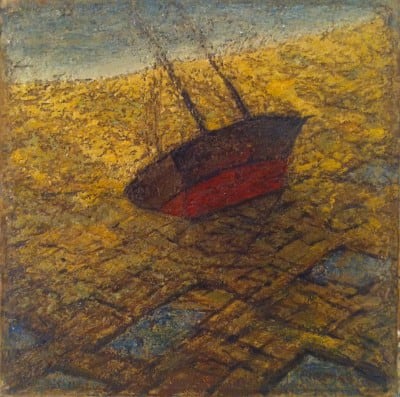Arnold Friedman

Beached Boat, circa 1940
Arnold Friedman (1874 – 1946)
Arnold Friedman is considered an extremely gifted and original American modern painter by scholars and art historians today. He came to the profession of a painter rather late in life and did not devote himself to his art on a full time basis until 1933, at the age of 59.
Friedman was born to Hungarian Jewish parents in Corona, Queens, where he worked as a post office clerk for some forty years, painting on evenings and weekends. Under the auspices of the Federal Arts Project of the Works Progress Administration, Friedman painted murals for Chalfonte-Haddon Hall in Atlantic City, New Jersey and post office buildings in Orange, Virginia; Kingstree, South Carolina; and Warrenton, Georgia.
Friedman’s style underwent several transformations during his career. He began his career in 1905 under the tutelage of Robert Henri and Kenneth Hayes Miller at the Art Students League in New York. These painters had an important influence on his early style, which was geared towards representational subjects. However, during his studies at the Art Students Leagues, Friedman found himself a misfit as an older postal clerk, and harnessed the belief that “every painter must learn his own trade. ”
In 1909 Friedman took a six-month leave of absence from his job at the Post Office to study art in Paris. During this time, he was exposed to the virtues of Impressionism. He was most influenced by the Pointillism of Pisarro, and reflected his admiration of other Impressionists and Post-Impressionists was reflected in his own art after his return to New York. Friedman’s trip to France also introduced him to Cubi`sm, which he experimented for a brief period. From these European influences, Friedman chartered his own distinctly American course and created a unique approach to painting.
Featured works
Biography
Upon his return to New York, Friedman’s style consisted of cool tonalities and smooth finish, with two-dimensional objects. He painted traditional subjects of landscapes, portraits, and nudes all expressing his deep commitment to color. It was during this time that he made the bold statement, “Color in painting is the very heartbeat (Hess).”
While Friedman developed several styles during the course of his career, his latest work continues to warrant the most attention. The artist maintained s commitment to nature and color as he developed an abstracting style, abandoning the brush for a palette knife. This method of painting allowed for more powerful effects of texture and abbreviated forms. Friedman’s abstracted landscapes attain an atmospheric quality through his use of color and unique application.
His style during his later career is distinct, as Friedman paints with impastoed surfaces that create contours and texture to define characteristics of his subject. Through these works he pays homage to the influence of Pisarro and Impressionism, yet he does so in his own vocabulary. Where an Impressionist landscape depicts a place and time, Friedman’s landscapes evoke mood. As an artist, he was more concerned with the formal aspects of painting rather than with creating the exact appearance of nature.
Prior to his death in his seventies, Friedman was still actively painting and developing his unique style.
Friedman’s oeuvre appears to have been limited to approximately 300 works. He is represented in the Metropolitan Museum of Art, Museum of Modern Art, Smithsonian Museum of American Art, Newark Museum, and Detroit Institute of Art. He was also a member of the Society of Independent Artists and Salons of America.
Biography from the Archives of AskART
